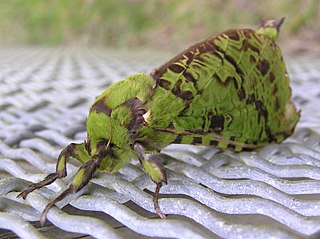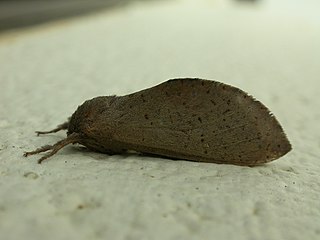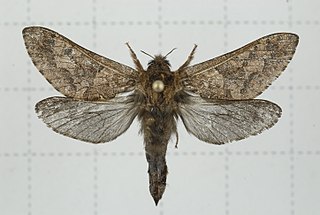
The Hepialidae are a family of insects in the lepidopteran order. Moths of this family are often referred to as swift moths or ghost moths.

Aenetus is a genus of moths of the family Hepialidae. There are 24 described species found in Indonesia, New Guinea, New Caledonia, Australia and New Zealand. Most species have green or blue forewings and reddish hindwings, but some are predominantly brown or white. The larvae feed in the trunks of living trees, burrowing horizontally into the trunk, then vertically down.
Antihepialus is a genus of moths of the family Hepialidae. There are four described species, found in southern and eastern Africa.

Aoraia is a genus of moths of the family Hepialidae. There are 13 described species, all endemic to New Zealand. The type species of this genus is Porina dinodes Meyrick, 1890. This genus contains some large species with a wingspan of up to 150 mm.
Bipectilus is a genus of moths of the family Hepialidae. There are eight described species in the genus, distributed through China, Nepal and Vietnam.
Cibyra is a genus of moths of the family Hepalidae. There are 50 described species, found throughout Central and South America.
Dalaca is a genus of moths of the family Hepialidae. There are 23 described species found throughout South America as far north as Panama. The larvae feed on grasses.

Elhamma is a genus of moths of the family Hepialidae. There are four described species found in Australia and New Guinea.

Fraus is a genus of moths of the family Hepialidae. There are 25 described species, all endemic to Australia.

Hepialiscus is a genus of moths of the family Hepialidae. There are four described species found in Taiwan and Nepal. The larvae feed on grasses.
Pfitzneriana is a genus of moths of the family Hepialidae. There are four described species, all found in South America.
Pfitzneriella is a genus of moths of the family Hepialidae. There are four described species restricted to Ecuador and Peru.

Phassodes is a moth genus of the family Hepialidae. As of 2018, it is monospecific, consisting of the sole species Phassodes vitiensis; this species is very variable. It is found in Fiji and Samoa. The life cycle is unknown but the larva is presumed to feed underground on the roots of plants or decaying matter.

Oreocallis is a South American plant genus in the family Proteaceae. There is only one species, Oreocallis grandiflora, which is native to mountainous regions in Peru and Ecuador.
Dalaca cocama is a species of moth of the family Hepialidae. It is known from Peru and Ecuador.
Dalaca niepelti is a species of moth of the family Hepialidae. It is known from Ecuador.
Druceiella amazonensis is a species of moth of the family Hepialidae. It is known from Brazil.
Druceiella metellus is a species of moth of the family Hepialidae first described by Herbert Druce in 1890. It is known from Ecuador.
Druceiella momus is a species of moth of the family Hepialidae first described by Herbert Druce in 1890. It is known from Ecuador.
This page is based on this
Wikipedia article Text is available under the
CC BY-SA 4.0 license; additional terms may apply.
Images, videos and audio are available under their respective licenses.







